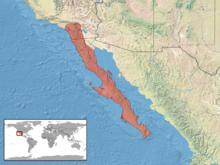Crotalus ruber
| Crotalus ruber | |
|---|---|

| |
| Scientific classification | |
| Domain: | Eukaryota |
| Kingdom: | Animalia |
| Phylum: | Chordata |
| Class: | Reptilia |
| Order: | Squamata |
| Suborder: | Serpentes |
| Family: | Viperidae |
| Genus: | Crotalus |
| Species: | C. ruber
|
| Binomial name | |
| Crotalus ruber Cope, 1892
| |

| |
| Synonyms | |
| |
Crotalus ruber (commonly known as the red diamond rattleback) is a species of venomous Pit vipers. There are currently three subspecies found.
Description[change | change source]
The Red Diamond Rattlesnake is a large species of Rattlesnake. It usually grows up to the length of 100 centimeters (39 in), but some males can grow up to the length of 140 centimeters (55 in). The largest ever found was 162 centimeters (64 in) long. Its pattern is similar to the "Western Diamondback Rattlesnake", but the Red Diamond Rattlesnake has more of a reddish color on it.
Common Names[change | change source]
This snake has many names like the "Red Rattlesnake", the "Red Rattler", the "Red Diamond-backed Rattlesnake", and the "Western Diamond Rattlesnake".
Where it lives[change | change source]
The Red Diamond Rattlesnake lives mainly in deserts and on mountains in Southwestern California, U.S.A, northeastern Baja California, Mexico, and islands in the Gulf of California like Angel de la Guarda, San Macros and Monserrate.

Diet[change | change source]
It eats mainly rabbits, ground squirrels, and birds, but sometimes they eat lizards and other snakes.
Reproduction[change | change source]
Red Diamond Rattlesnakes mate in February and April. Females have their babies in August; they have around 3 to 20 babies at a time. The babies are born 30 to 34 cm long.
References[change | change source]
- ↑ McDiarmid RW, Campbell JA, Touré T. 1999. Snake Species of the World: A Taxonomic and Geographic Reference, vol. 1. Herpetologists' League. 511 pp. ISBN 1-893777-00-6 (series). ISBN 1-893777-01-4 (volume).
Other websites[change | change source]
- Crotalus ruber at the TIGR Reptile Database. Accessed 12 December 2007.
- Crotalus exsul (=Crotalus ruber) Red Diamond Rattlesnake at San Diego Museum of Natural History. Accessed 7 February 2007.

